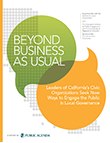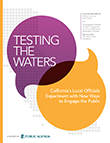Beyond Business as Usual: Leaders of California’s Civic Organizations Seek New Ways to Engage the Public in Local Governance
What opportunities do Californians have to engage with public issues and influence decisions that affect their lives? What stands in the way of productive dialogues between local officials and the residents they serve? What are the possible ways to strengthen relations between local government and the publics they serve?
The perspectives of civic leaders and their organizations
To provide some answers to these questions, we conducted a research study that sought the opinions of more than 900 local officials and 500 leaders of civic and community-based organizations in California. We asked these local officials and civic leaders about their efforts to engage the public in decision making, their experiences with traditional public hearings at council and commission meetings and their interests and attitudes toward newer forms of public engagement—especially methods that seek to give broad cross sections of the public the opportunity to deliberate over local issues and weigh the trade-offs of policy decisions that affect their lives.
This report—the second of two summarizing this research—presents what we learned from surveying and interviewing leaders from civic and community-based organizations across California.
This report is divided into two parts. We first present the
findings from our statewide survey of 462 leaders of civic and
community-based organizations. These findings complement those
from our research on California’s local officials’ attitudes,
experiences and concerns regarding the state of public
participation in local government decision making, experiences
and concerns of local city and county officials regarding the
state of public participation in local government decision
making. The second part of this report zeros in on the views of
leaders from 20 community-based organizations that work
predominantly with traditionally disenfranchised communities,
including low-income, ethnic minority and immigrant populations.
Finally, we discuss a number of important practical
recommendations that emerge from this research and its companion
study on local officials.
Companion study: Local public officials’ perspective
Results from our parallel study with elected and non-elected
local public officials are detailed in a separate report,
“Testing the Waters: California’s
Local Officials Experiment with New Ways to Engage the Public.”
See a PDF of the report, “Beyond Business as Usual,” at right. See both the executive summary and report of the companion study below.






